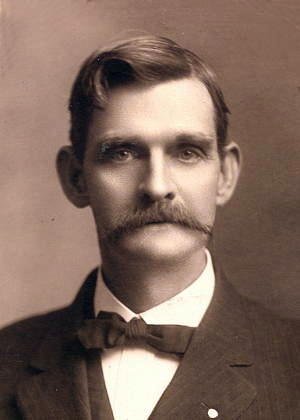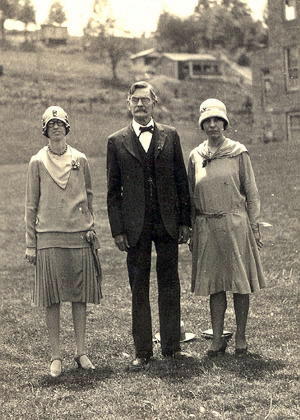DR. W.T.W. DYE NEARLY PERISHES 122 YEARS AGO AT HUR - "The Coldest Of Nights"

Dr. W.T.W. Dye of Grantsville (1860-1940)
(Photo Courtesy of David B. Hathaway)
By Bob Weaver
It was not the first nor the last encounter with death with one of Calhoun's pioneer physicians.
122 years ago (Jan. 1900) Dr. W.T.W. Dye (pictured above in a 1917 photo) and Dr. A.C. Blair left Grantsville, climbed the steep Pine Creek Hill above the town on their horses, and set-out for Richardson.
Their mission on this coldest of nights was to amputate Al Nichol's leg.
Blair stopped at Peter Hicks' place on Big Fork, known as "Darky Fork," to get a cup of coffee. The hospitable Hicks family lived in the narrow valley, one of two early black communities in the county.
Dye went ahead, up the hollow to the Joker Ridge, where he waited for his fellow physician. Getting off his horse and standing in the snow and blowing wind, he almost perished.
Then, they rode by single file around the narrow Joker Ridge toward Hur, years before an official highway was constructed.
Dr. Blair was in the lead. Arriving in the vicinity of Hur, riding very fast, Dr. Dye's mare left the road and jumped into a field, throwing him over an embankment.
Blair, being numb with cold, did not miss his comrade for some time. After traveling back on the narrow trail, he could not find him. Giving up the hunt, he went to the home of Slathial Buck and waited until the break of day.
Dye was unable to get on his horse, and in that struggle took off his overcoat, his gloves and ear muffs, almost perishing with cold. He then managed to find a hay stack and pulled out some hay and stretched out to die.

In later years, W.T.W. Dye With Two Early High School Teachers
(L-R) Miss Charlotte Seward (Librarian), W.T.W. Dye, M.D., Orma Melton.
Miss Melton was a teacher and later a Baptist Missionary to China
Dr. Blair, along with the Buck family and most likely other neighbors, began a search for the missing physician. A newspaper account says "He was found in time to be brought around," and was hauled home on a sled to quickly improve.
There was no account about what happened to Mr. Nichols and his bad leg.
In 1894 when he was returning from a professional call on Yellow Creek by way of Spring Fork, near the residence of Robert Ferrell, his horse broke "through that old nuisance of a bridge," throwing him on his face and breast, receiving serious injuries.
A newspaper account said his head was badly hurt. He was also mashed about the hips and back.
The doctor reported the horse fell on him, saying that he lay there on the bridge in an unconscious state for about three hours. Coming to himself, he was unable to scream or make himself heard at the Ferrell house, which was not over a 100 feet from the bridge.
Luckily some people who had been to a literary by chance passed that way and found him, carrying him into the house. Dr. Swentzel was summoned and "did all that could be done to allay his great suffering," reported the newspaper.
A few days later, it was learned that Dye's injuries were much worse than first thought. It was necessary to carry him home, a distance of six miles. But willing and strong men took hold and he was soon conveyed through deep and sticky mud.
"No man nor woman will ever suffer in this community so long as human skill and human attention can possibly prevent it. We are glad to announce that the Dr. is now in a fair way to a speedy recovery," concluded a newspaper account.
W. T. W. Dye and his brother James Dye, were both early Calhoun physicians, the latter practicing in the West Fork area of the county.
W. T. W. Dye (1860-1941)is buried with his wife Sophia Rogers (1868-1948) in Bethlehem Cemetery. His daughter, Eva Dye Hathaway (1888-1958), wife of Fred, is also buried beside him.